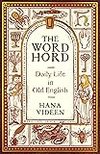
Saved by Margaret Leigh
The Wordhord

Saved by Margaret Leigh
Although modern English 'sibling' comes directly from sibling (with the same root as sib-lufu), the Old English word means kin in general, not brothers and sisters specifically. Sib-lufu describes God's love for the angels, who are his children and therefore kin. But few siblings today are likely to describe each other as angels.
Near the end of [Beowulf], a dragon experiences lyft-wynn (air-joy), the pleasantness of the air or the joy experienced when flying: 'At times during the night it possessed air-joys (lyftwynne).'
Lēod-wynn (people-joy) is what you feel when you're with your people, a joy that comes from a sense of community. The hapax appears in a prayer for patience and humility in the poem Resignation . A solitary being, says the poem, cannot live long without 'people-joy (leodwynna), without friends.
Symbel-gāl (feast-lustful) is when you are so overwhelmed by the pleasures of food and drink that you are unable to focus on what's important. The word is a hapax in a Judgement Day poem, which tells about a man who spends too much time thinking about the pleasures of worldly life. The man forgets to pay attention to the fate of his soul: 'Little
... See moreA limit of three nights for a host receiving a guest is actually specified in the law codes of two seventh-century Kentish kings. ... During the twelfth century (in the Middle English period) a similar rule appears in the law code attributed to Edward the Confessor but with more detail: a guest is only a guest for the first three days; after that,
... See moreLearning itself is a 'craft' in Old English, for cræft is a wonderfully versatile word; it can mean 'power', 'strength', 'art', 'skill', 'trade', 'cunning, knowledge' or 'virtue'. Leornung-cræft (learning-craft) is thus 'education' or 'erudition'. 'Craft' survives in modern English, but unfortunately we have lost some compound words like
... See moreThe dæg is youngest at üht. Üht is just past night's end, the time right before daybreak. It is followed by dag-red (day-red), when the day reddens with the first light of dawn, or dæg-rima (day-rim or day-border), the narrow space of time between night and day, when the sun just peeps over the horizon. Dæg-rēd and dæg-rima are followed by
... See moreAlthough black was the most common colour for writing (as it still is today), red-orange ink was the base pigment for illustrations. Red-orange was used to outline illustrations before adding all the other colours on top. Illustrations in medieval manuscripts are often called 'miniatures', which is rather confusing; after all, some are large,
... See moreMost languages undergo semantic narrowing, usually because a particular definition for a word begins to be used more frequently than others. In the case of 'meat', people must have used the word specifically for animal flesh more and more frequently until a point in time when 'meat' sounded strange when used for any other sense. So although the
... See more